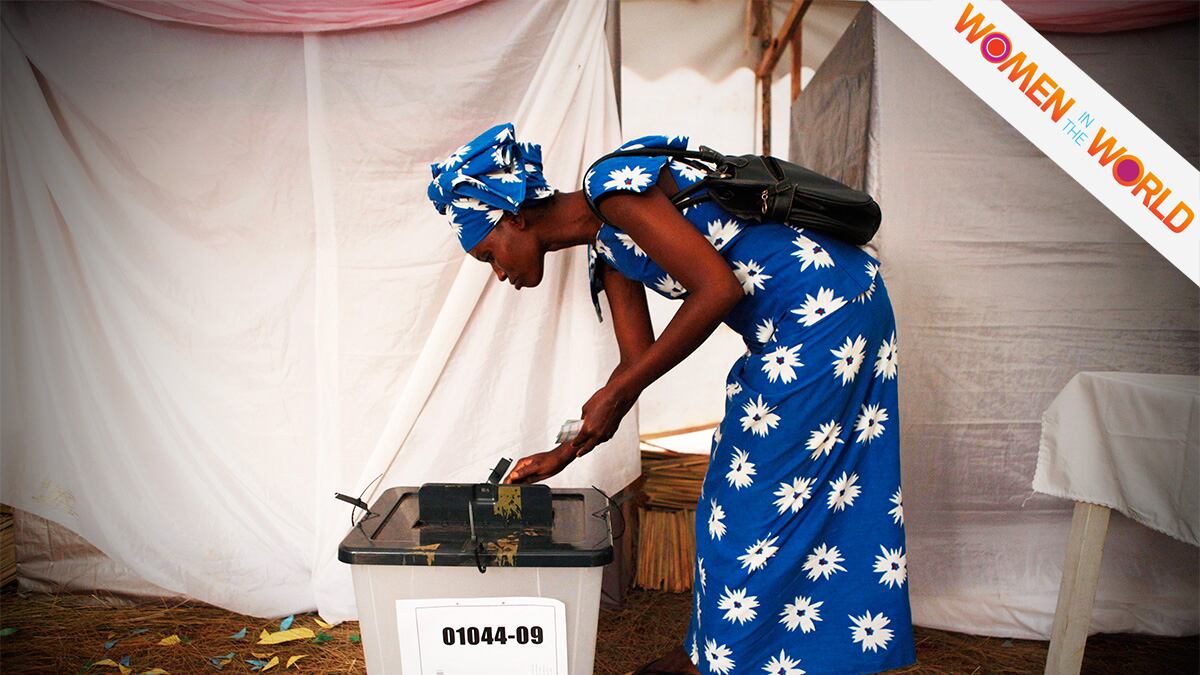Rwanda has the highest percentage of women appointed to government in the world. Women account for 64 percent of its parliament. (In comparison, America ranks 83rd with 18 percent.)
This is the same country that 20 years ago was in the throes of a genocide that consumed its population at a speed unparalleled in modern history. In 1994, Rwanda experienced 100 days of bloodshed that left some 800,000 people dead.
In the aftermath, the country was shattered. As the liberating rebel army moved in, it pushed the genocidal militias, along with hundreds of thousands of Rwandan refugees, into neighboring countries. While the world focused on the refugees, the Rwandans who remained in their own country were left to fend for themselves in a decimated nation. The population that stayed behind in the ruins was about 70 percent female.
The traditionally patriarchal society thrust its women into the role of rebuilding the country. They formed local councils, headed judicial proceedings, tilled the land, and rose through the ranks of government. Amazingly, against a backdrop of near total ruin, they ushered in a level of peace and reconciliation that whipped the country into the model of development and gender equality it is today.
One of those rebuilding was Eugenie Mukeshimana. In 1994, she was 22 years old and 8 months pregnant when war broke out and her husband was killed. Pursued for being a Tutsi, she took refuge with three different families, who hid her in the capital of Kigali. She gave birth in the outhouse of one of those families. The next day, she was taken to be killed, but, thanks to muddled instructions, her life was spared and she was subsequently liberated by the rebel Rwandan Patriotic Front (RPF) army.
It took months, she said, for any semblance of normality to take root. The abnormal “became normal,” Mukeshimana remembers: On the weekends, they would dig up human remains from outdoor latrines and wash and rebury bones.

Finances were another burden. “Under normal circumstances, family would help if I lost my husband. After the genocide, there was no such luxury,” she says. She remembers her female friends discovering that they had homes to pay off, their husband’s businesses to run, or legal obstacles blocking inheritance money to overcome. They—and she—felt, “that either way you have to go out and earn a living. You could not stay at home when you have kids dependent on you.”
Mukeshimana, who had a high school education, got a job as an office manager for a construction company. She would visit the building sites and observed the women coming to apply for jobs. “The men were ridiculing them, but not only were the women faster, they were much better then the guys. But they had to prove they could do it,” she remembers.
“It was women really simply saying, ‘I’ve been a housewife and now instead of taking care of a house I need to build a house, so someone show me how to make bricks,’” says Swanee Hunt, founder and chair of the Institute for Inclusive Security. Hunt, who has been working in Rwanda since 2000, remembers an early meeting she had with President Paul Kagame. She asked him if there was a difference in how men and women responded in the aftermath? “Women stepped out and rolled up their sleeves when men were destroyed emotionally and psychologically,” he told her.
The women discovered they could convey the needs of communities: they knew about issues of health, education, and family life. Before the genocide, men made the moneymaking decisions. Now, with women at the helm, the income was being invested in families and households. On a national level, leaders of both genders were seeing the obstacles facing their female relatives and friends and channeling them into policy reform.
The reversal didn’t have the markings of a textbook feminist revolution: there was no picketing, there were no marches and no political pleas. “We don’t talk too much, but we get things done,” says Mukeshimana. “Before men knew it—or women themselves—they’d built something incredible that cannot be taken away.”
Leadership started on the community level, where six women would compose a local women’s council. “A decade earlier in society for a woman to speak in a meeting with men, it was not just socially uncommon, it was impossible,” says Hunt. She remembers Kagame once telling her that he decided at an early age that there would be no exclusions in his work. “If I’m working on people’s rights, how do I exclude women?” he thought. The movement of Rwandan women through government was made permanent by a 30 percent quota prescribed by the new government’s constitution, which also established a gender monitoring office.
“After 1994 genocide [the RPF was] encouraging all groups of communities to take part in rebuilding the country. For us it was an open involvement for anyone who was ready to work for their country,” says Oda Gasinzigwa, minister of Gender and Family Promotion. “There’s no way you can ignore a part of your community if you want it really to develop.”
Gasinzigwa was one of the many Rwandan refugees who returned home to rebuild their decimated country in the war’s aftermath, and she found a force of women leaders in place motivating the younger ones to join their ranks.
In 2001, after working to coordinate empowerment programs for the National Women’s Council, she was also elected to the council at the grassroots level by her village.
This was a story repeated many times over: women holding community council seats rose through the regional levels to the national council. The secret to “how they broke every record,” Hunt says, was that women on the lower councils ran for the set-aside national seats to fill the government quota and women on the national council ran against men.
These groups of female leaders became a model for reconciliation. “Women whose families had been slaughtered [were] sitting next to another woman going every day to deliver food to a husband in prison because he was genocidaire—and they’re forming a women’s caucus in the parliament,” Hunt says. Meanwhile, the Rwandan Gacaca courts—community-run justice systems that tried some two million genocide perpetrators—had strong female leadership.
“The chaos can either set you back 100 years or crack open the culture,” says Hunt. “Things are never going back to where they were before and if you are adept enough as women, you can slip into those places where there are cracks and vacuums and fill them.”
In December, Hunt says she asked Louise Mushikiwabo, minister of foreign affairs and cooperation, what would ensure a woman’s place in Rwanda when there was a new administration. “She said, ‘It’s no longer a question of quota insuring anything in the culture, it is the culture now.’”
Hunt, who is compiling interviews with the country’s female leaders in a forthcoming book called Rwandan Women Rising, has been bringing a contingency of the country’s top women to a program she runs out of Harvard’s Kennedy School of Government, where she serves as the Eleanor Roosevelt Lecturer in Public Policy. The program unites female leaders of former or current conflict zones, from Kosovo, to Colombia, to Afghanistan.
Now other countries look to Rwanda as an example of women’s impact on government and the peace process. Recently, Hunt says, Rwandan women told their counterparts in Syria, “Look, we have been through what you’re going through… we have been through it and look at us.”
The Rwandan success story was not without a price, and for some the scars were slow to heal, when they healed at all. After seven and a half years in Rwanda after the war, Mukeshimana moved to the United States on a student visa, and later was granted asylum. “I could not see myself living next door to people who have victimized me and family,” she says.
Today, she lives in Newark, N.J., and runs the Genocide Survivors Support Network, which she founded in 2010 to help victims and asylum seekers resettle in the United States. The legal and social hoops are taxing for immigrant survivors, who are forced to repeat their stories over and over in a process that can be traumatizing.
For mothers of the genocide, personal histories can be hard to pass on to the next generation. “It’s hard to be a parent and also to be a survivor: to talk to your kid as if you are like everybody else, but you know you’re not,” says Mukeshimana, whose daughter is “almost 20 and I don’t know when to have this conversation.” For advice, she has sought the counsel of Holocaust survivors, whose wisdom resonated across the half-century separating the two genocides.
Meanwhile, in Rwanda, a generation the same age as Mukeshimana’s daughter has grown up without memories of the genocide—or the patriarchal society that preceded it. They’re getting educated, with 98 percent of girls enrolled in primary school, and they have plenty of role models to emulate.
This generation of young women is “doing things that in my time at their age I wasn’t thinking about because society spelled it out to me that there were those limitations,” Mukeshimana says.
“I am amazed, I’m proud—but at the same time, it shouldn’t take a conflict as big as genocide for these changes to take place. There should be a better way to make the transition to gender equality without having conflict as a backdrop.”
Watch the Women in the World Summit live on The Daily Beast starting Thursday, April 3 at 6:30 p.m. EST.






